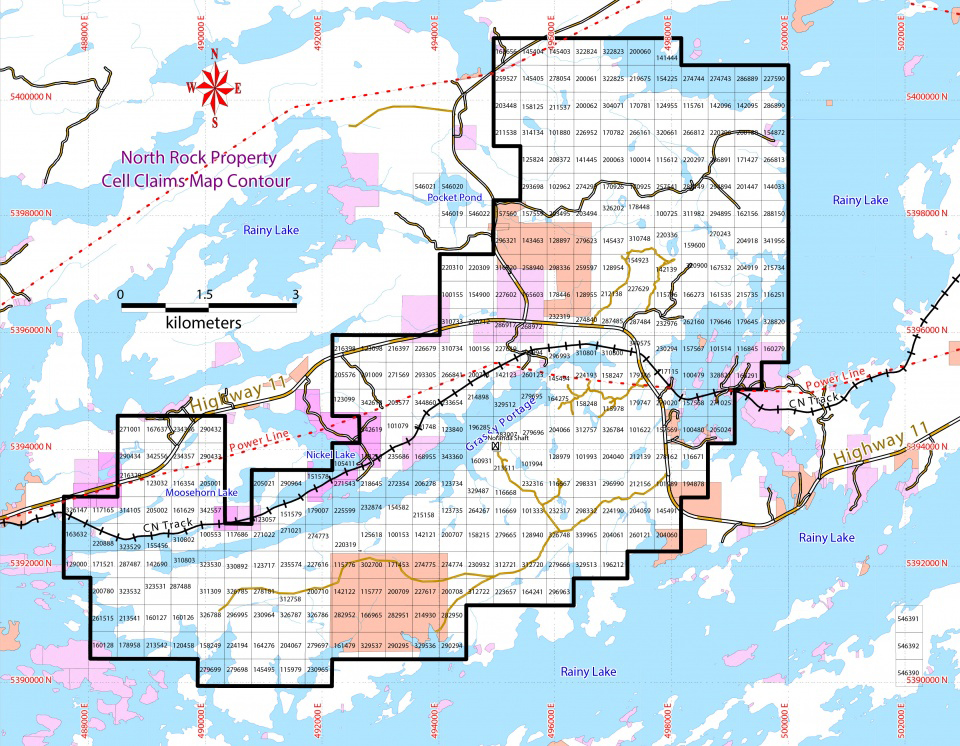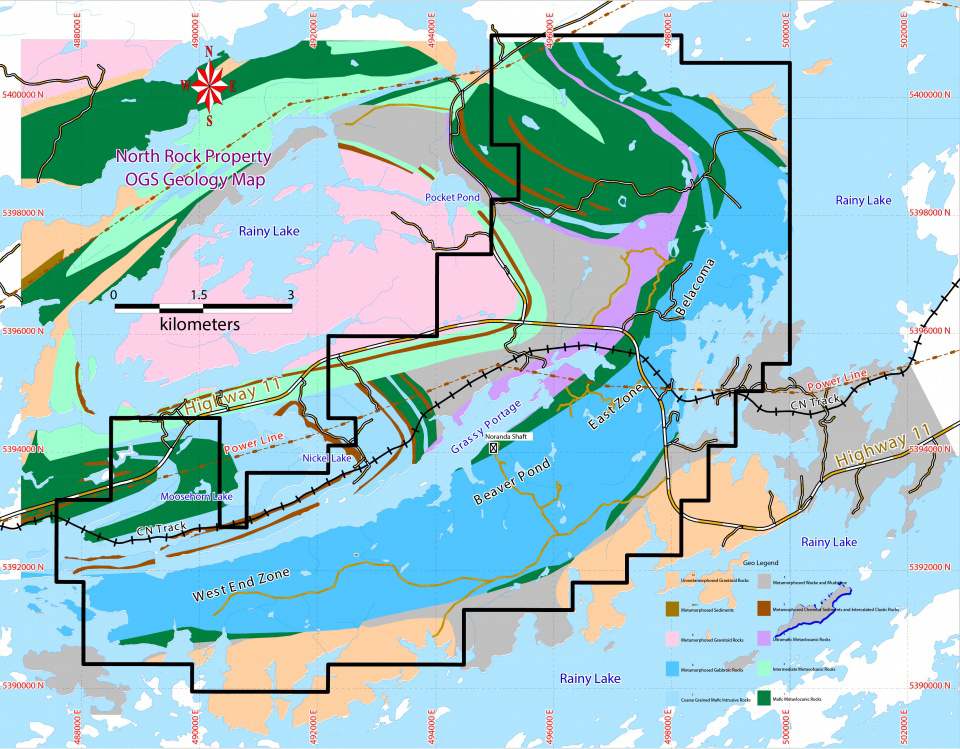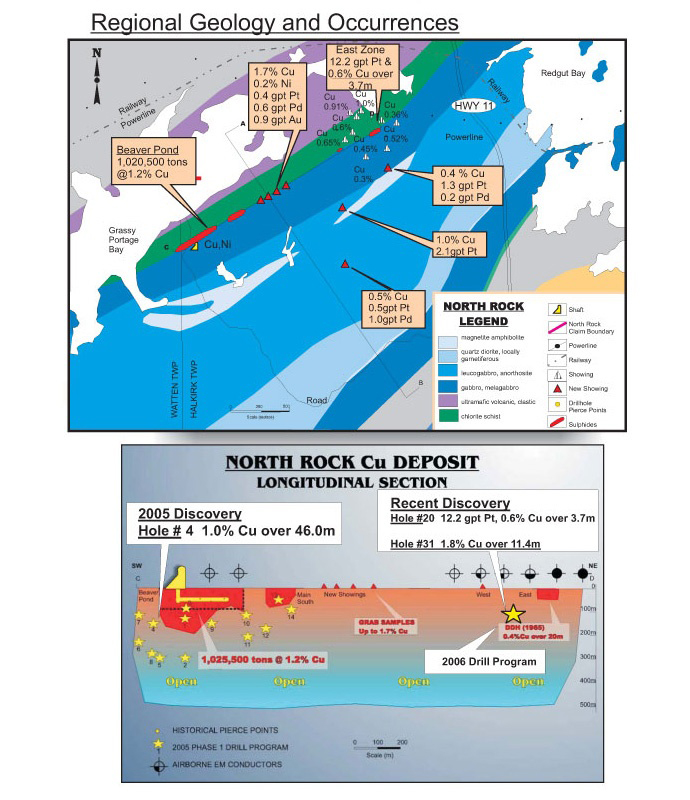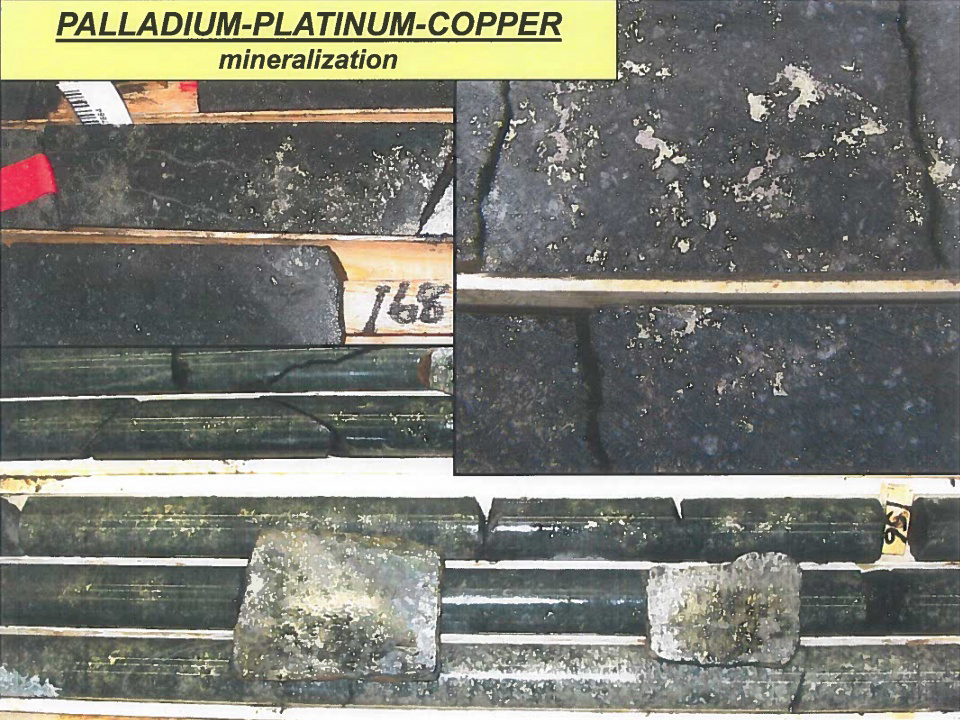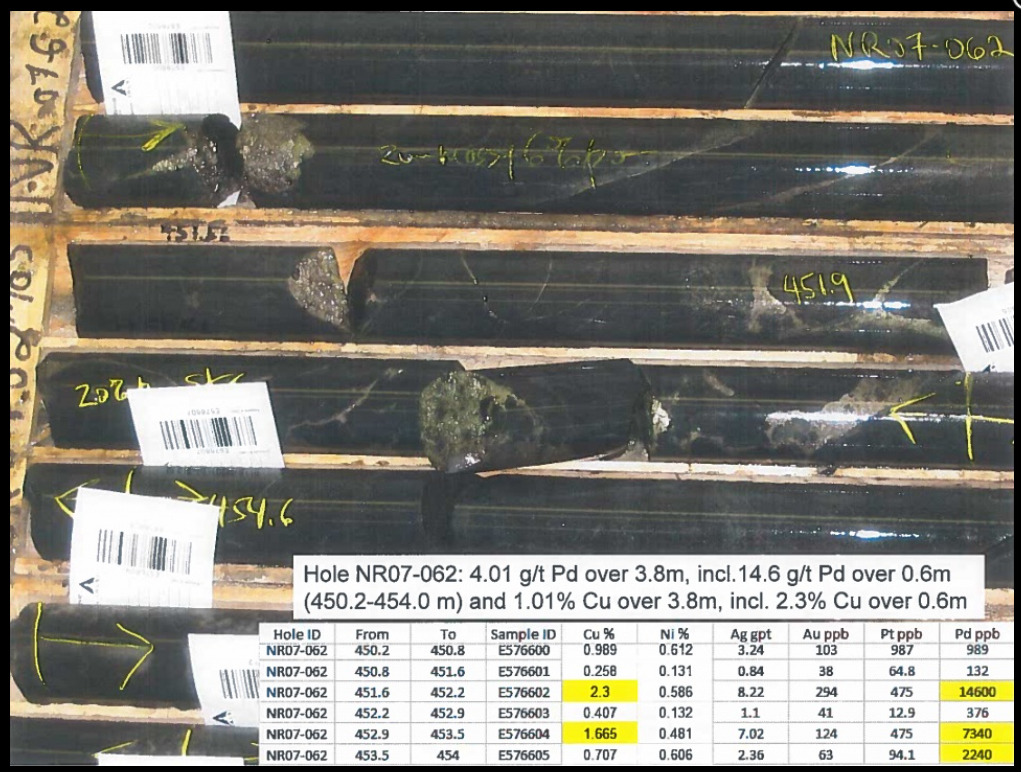North Rock: Copper-Nickel-PGE
Ontario, Canada
Status
Tier 2 Project, available for Joint Venture
Target
Copper-Palladium-rich, magmatic copper-nickel-PGE mineralization hosted by an Archean age mafic intrusion.
Location and Setting
The 100% owned North Rock Property is located approximately 25km east of Fort Frances in northwestern Ontario and is easily accessed via Highway 11 and local gravel roads.
Claim Map of the North Rock Property
Land Status
The property is 100% owned and consists of 343 unpatented claims totalling 7,031 hectares.
Geology and Mineralization
The Property is underlain by the 20km long Grassy Portage layered mafic intrusion and hosts four known zones of magmatic copper-nickel-PGE mineralization; the Beaver Pond, the Main South, the East, and the West zones all of which occur at or near the base of the intrusion, along its western contact.
Copper-Nickel Mineralization
The most significant of the zones is the Beaver Pond Zone, which was discovered by Noranda in 1958 and subsequently explored from underground via a 90-metre-deep shaft and one drift on the 70 m level. Historic Resource estimates for the Beaver Pond Zone, reported by Bergman (1973) range (depending on the cut-off grade) from 1,020,458 tons grading 1.17% copper to 265,230 tons grading 2.08% copper. The resource estimate was calculated to a depth 90m, and the deposit appears to remain open to depth. One drill hole intersected 2.21% Cu over 36.5 feet at a vertical depth of 175 metres. (Note that these historical resource estimates are not in compliance with National Instrument 43-101 (a qualified person has not done sufficient work to classify the historical estimate as current mineral resources or mineral reserves; accordingly, Metalcorp is not treating the historical estimate as mineral resources or mineral reserves).
Geology map of the North Rock Property
Total Field magnetic map of the North Rock Property
Other significant drill intersections reported by Noranda from within the Beaver Pond Zone include: 4.3% Cu over 8.1m, 4.1% Cu over 7.8m, 3.4% Cu over 8.0m, 1.5% Cu over 21.3m, and 1.0% Cu over 55.5m. These Noranda assays have not been verified and as such should not be relied upon. There is no record of any further mineral exploration work having been conducted on or near the Beaver Pond Zone, or on any of the formerly leased claims in the area since the underground program was concluded in 1973.
Very little historical data exists regarding the abundance and distribution of nickel, cobalt, platinum group metals (PGM) or gold in the magmatic sulphide deposits present on the North Rock Property. However, recent grab sampling of a 10,000-ton surface stockpile of material recovered from underground development of the Beaver Pond Zone yielded assays of up to 8.9% Cu, 0.8% Ni, 0.05% Co, 1.6 gpt Pt, 0.7 gpt Pd and 0.7 gpt Au. Although grab sample assays are typically not representative of the overall grade, these results do confirm the presence of significant nickel, cobalt, PGM and gold values associated with the copper mineralization.
Local Geology of the Beaver Pond and surrounding Zones.
The three other known sulphide zones are less explored and occur over a 1.5km strike length along the base of the intrusion extending northeast from Beaver Pond Zone. These areas, as well as several other sulphide occurrences higher up in the intrusion, are all considered highly prospective for hosting additional magmatic nickel-copper (+/- PGE's, Co) sulphide mineralization.
Surface exploration, an airborne MAG/EM survey and three phases of drilling was conducted on the Property from 2005 to the end of 2007. In 2008 the Property was optioned to Kennecott Canada Exploration Inc. after discovering micro-diamonds. Kennecott returned the Property to the Company in September 2009.
The first phase of drilling was carried out in 2005 and consisted of 14 diamond drill hoes totaling 3,906 metres. Phase 1 drilling was designed to test the depth extension of the known copper mineralization at the Beaver Pond Zone. All drill holes intersected widespread, varied amounts of net -- textured copper -- nickel sulphide mineralization like that reported by previous drilling by Noranda. Hole 4 appears to have intersected the core of the zone assaying 1.5% copper over 13.7 metres. The drilling also intersected a "hanging wall Platinum Group Metal (PGM) zone that can be traced for 500 metres along strike and to a depth of 200 metres. Assay values as high as 3.7 g/t Pt + 7.1 g.t Pd over 0.8 metres were reported.
The Company completed an airborne magnetic/EM geophysical survey over the property which detected several anomalies with a one-kilometre-long anomaly coincident with the East zone which is 1.2 km northeast and along strike of the Beaver Pond zone. Mapping and sampling confirmed the presence of PGM mineralization at the East zone and a Phase 2 drill program was set up to test the mineralization. The Company drilled 21 holes totaling approximately 4,000 metres with several holes intersecting PGM mineralization. Hole 20 intersected 3.7 metres (2.5 metres true width) from 151.9 to 155.6 metres grading 12.2 g/t Pt, 0.1 g/t Pd, 0.1 g/t Au, 0.6% Cu and 0.2% Ni (see March 6 and April 19, 2006, news releases)
Significant Drill Intercepts
In June 2007 the Company announced a Phase 3 diamond drill program of 25 holes totaling approximately 8,000 metres to test several airborne EM conductors over a 20km strike length on the entire Property. Drilling in the Belacoma area, approximately 4.0km northeast of the Beaver Pond Zone, intersected Platinum, and Palladium mineralization as well with the following values: 3.5 g/t Pd over 2.8m, 1.2 g/t Pt and 1.0 g/t Pd over 1.0m, 2.9 g/t Pd over 0.9m and 1.6 g/t Pd over 0.9m. Several other airborne EM conductors were tested with the majority explained by pyrrhotite veins and/or sulphide iron formation. The sulphide iron formation in the Nickle Lake area was found to be zinc rich with the best assay from hole #57 of 0.5% Zn over 19.6m.
Detailed Economic Geology
As part of its ongoing exploration program the Company announced in February 2008 the discovery of micro-diamonds on the Property in the Grassy Ultramafic Pyroclastic. The Company took a 100kg sample and sent it for processing by Kennecott Canada Exploration Inc. ("Kennecott") in its Mineral Processing Laboratory, located in Thunder Bay, Ontario. A total of six diamonds were recovered with one (1) sitting on the 0.212mm sieve, three (3) were on the 0.106mm sieve and two (2) were less than the 0.106mm sieve size. In December 2008 Kennecott and MetalCorp signed an option agreement to explore for diamonds on the Property but in September 2009 MetalCorp was advised by Kennecott that it had completed processing a 1,200 kg sample taken during its summer exploration program and based on the results, concluded that the diamond potential is very low. Accordingly, Kennecott terminated its program and its option and returned the Property to MetalCorp.
Examples of North Rock Cu-rich mineralization
North Rock hole NR06-020, with high grade "footwall" style chalcopyrite vein an associated high platinum mineralization.
North Rock Hole NR07-062 with high palladium values.
Example of Cu-rich mineralization from the Beaver Pond stockpile.
Proposed Exploration Program
A Bore Hole Electromatic Survey ("BHEM") followed by diamond drilling is proposed to explore for semi-massive to massive sulphide a depth along the lower contact of the Grassy Portage Intrusion.
Agreement and Terms
All claims are 100% owned.

